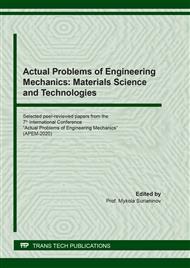[1]
Burova O.G., Urbanistika. 1 (2019) 79-87.
Google Scholar
[2]
Chepurna S.M., Zhydkova T.V., Chepurna M.Ie. Zbirnyk naukovykh prats «Suchasni tekhnolohii ta metody rozrakhunkiv u budivnytstvi». 10 (2018) 195-204.
Google Scholar
[3]
Dedeneva E.B, Demina O.I, Stelmakh A.A., Rachkovsky A.V. Priority areas of science and technology. (2014) 60-64.
Google Scholar
[4]
Е. Dedenyova, O. Demina, student A. Volkova, A.A. Krivitskaya, Collected scientific works of Ukrainian State University of Railway Transport. 152 (2015) 187-192.
Google Scholar
[5]
S. Chepurna, O. Borziak, S. Zubenko. Materials Science Forum. 968 (2019) 82-88.
DOI: 10.4028/www.scientific.net/msf.968.82
Google Scholar
[6]
Kovalchuk O., Grabovchak V., Govdun Y. MATEC Web of Conferences. 230 (2018) 03007.
DOI: 10.1051/matecconf/201823003007
Google Scholar
[7]
P. V. Krivenko, M. Sanytsky, T. Kropyvnytska, R. Kotiv. Advanced Materials Research. 897 (2014) 45-48.
DOI: 10.4028/www.scientific.net/amr.897.45
Google Scholar
[8]
Ustinova A.A., Potapova E.N., Konyashkina A.Yu. Advances in chemistry and chemical technology. XXXI (3) (2017) 114-116.
Google Scholar
[9]
E.A. Belychenko, S.N. Tolmachev. Mizhvuzivskyi zbirnyk «Naukovi notatky». 45 (2014) 31-36.
Google Scholar
[10]
Kononova O.V., Cherepov V.D. Sovremennыe problemы nauky y obrazovanyia : Tekhnycheskye nauky. 1(2013) 227-234.
Google Scholar
[11]
V. Rahhal, V. Bonavetti, L. Trusilewicz, C. Pedrajas and R. Talero, Elsevier Magazine: Construction and Building Materials. 27 (2017) 82-90.
DOI: 10.1016/j.conbuildmat.2011.07.021
Google Scholar
[12]
V.K. Kozlova, A.M. Manokha, A.A. Lykhosherstov [and others]. Tsement y eho prymenenye. 3 (2012) 53-57, 60.
Google Scholar
[13]
Korenkova S.F., Sidorenko Yu.V. 5th International Conference on Science and Technology (2015) 6-15.
Google Scholar
[14]
Arshinnikov D.I., Svidersky V.A. Technology audit and production reserves, 4 (2015) 7-11.
Google Scholar
[15]
I.M. Gorkova et al., Priroda prochnosti i deformatsionnyie osobennosti mela i nekotoryih melopodobnyih porod, Akademiya nauk USSR, (1962).
Google Scholar
[16]
Kuznetsova T.V., Kudriashov Y.V., Tymashev V.V. Hosudarstvennoe yzdatelstvo lyteraturы po stroytelstvu y arkhytekture USSR (1958) 5-16, 49-66.
Google Scholar
[17]
Poluektova V.A., Lomachenko V.A., Stolyarova Z.V., Lomachenko S.M. [and others], Basic Research: Technical Sciences. 9 (2014), 1205–1209.
Google Scholar
[18]
Marushchak U., Sanytsky M., Sydor N., Braichenko S. MATEC Web of Conferences 230 (2018) 03012.
DOI: 10.1051/matecconf/201823003012
Google Scholar
[19]
Krivenko P., Petropavlovskyi O. & Kovalchuk O. Eastern-European Journal of Enterprise Technologies. 1(6-91) (2018) 33-39.
Google Scholar
[20]
O.S. Borzyak, S.M. Chepurna. Collected scientific works of Ukrainian State University of Railway Transport. 175 (2018) 110-117.
Google Scholar
[21]
U. Маrushchak, M. Sanytsky, T. Mazurak, Y. Olevych, Eastern-European Journal of Enterprise Technologies. 6/6 (84) (2016) 50-57.
DOI: 10.15587/1729-4061.2016.84175
Google Scholar
[22]
M. Sanytsky, T. Kropyvnytska, R. Kotiv, Advanced Materials Research. 923 (2014)42-47.
DOI: 10.4028/www.scientific.net/amr.923.42
Google Scholar
[23]
O.S. Borziak, A.A. Plugin, S.M Chepurna, O.V. Zavalniy and O.A. Dudin. IOP Conference Series: Materials Science and Engineering (MSE) 708 (2019) 012080.
DOI: 10.1088/1757-899x/708/1/012080
Google Scholar
[24]
DSTU EN 196-1: 2007. Methdos of testing the cement. Part 1. Determination of validity (EN 196-1: 2005, IDT) (State standard of Ukraine, Kyiv, 2007).
Google Scholar
[25]
DSTU B.V. 2.7-170:2008. Construction Materials. Concretes. Methods for determination of average density, humidity, water absorption, porosity and water resistance. (State standard of Ukraine, Kyiv, 2009).
Google Scholar
[26]
DSTU B.V. 2.7-42-97. Construction Materials. Concretes. Methods for determining water absorption, density and frost resistance of building materials and products. (State standard of Ukraine, Kyiv, 1997).
Google Scholar
[27]
DSTU B.V.2.7-257:2011. Portland cement white. Specifications. (State standard of Ukraine, Kyiv, 20127).
Google Scholar


